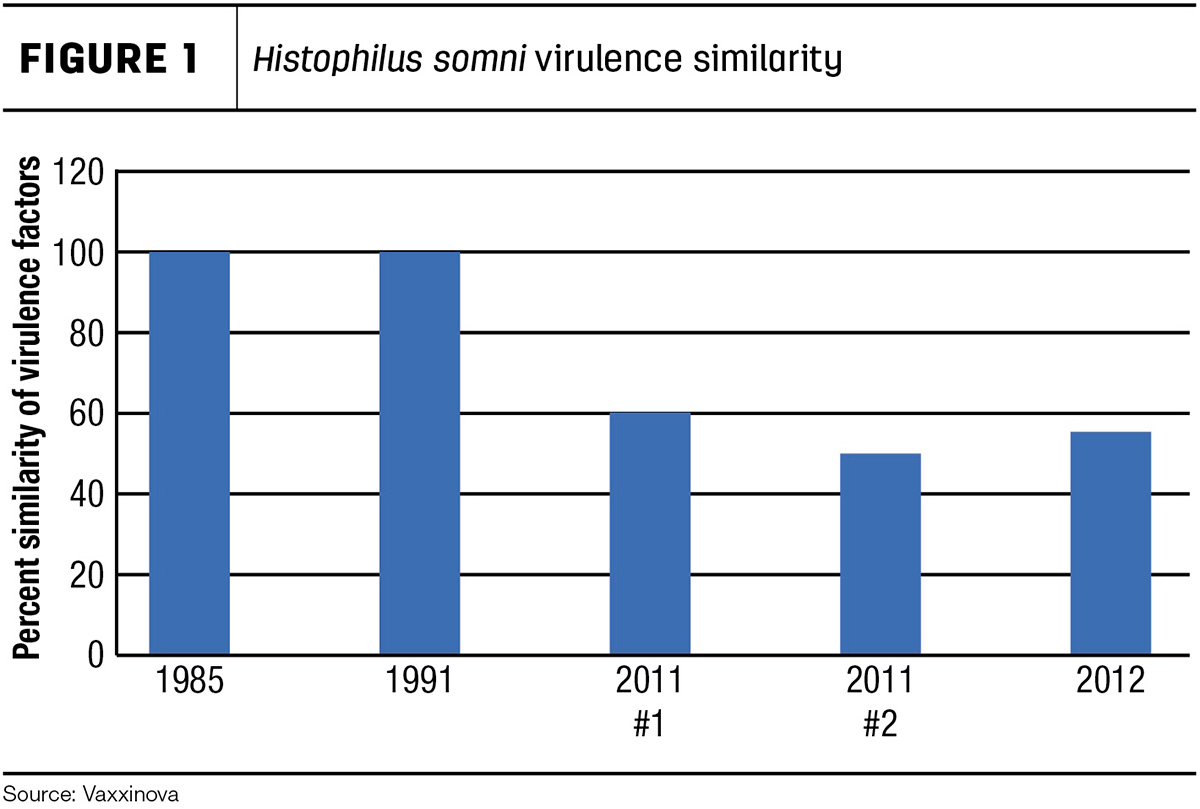Histophilus somni (H. somni), formerly known as Haemophilus somnus, is a common cause of disease in cattle. H. somni is a bacterial pathogen that can cause an acute, often fatal disease that may involve the respiratory, cardiovascular, musculoskeletal, reproductive or nervous systems. Although feedlot cattle of any age are potentially at risk, the disease is more common in recently weaned and/or shipped cattle.
H. somni can be a naturally occurring organism in cattle, found in the nasal passages of normal, healthy cattle. The prevalence of this organism is very high, with some herds reported to be 100% seropositive, indicating that all the cattle in those herds have been exposed. H. somni has several characteristics that contribute to its ability to cause disease, including the release of an endotoxin that damages the cells lining the blood vessels, suppression of white blood cells and interference with many of the normal defense mechanisms cattle have to fight disease.
Clinical syndromes
H. somni can cause a variety of clinical syndromes including pneumonia, thrombotic meningoencephalitis (TME), reproductive disease, joint infections and heart disease, resulting in sudden death.
Pneumonia
Typically, bovine respiratory disease (BRD) outbreaks in cattle occur within seven to 14 days of arrival to the feedlot; H. somni-caused BRD cases tend to occur later, at 30 or more days on feed. H. somni is a major contributor to the incidence of “late-breaking” BRD outbreaks.
The bacteria is often found in combination with Pasteurella multocida or mycoplasmas, all of which produce biofilms. Biofilms are a polymer-like matrix secreted by certain bacteria, which serve to shield the bacteria from antibiotics and the cattle’s immune system. These bacterial biofilms contain clusters of bacteria within the matrix. Organisms that produce biofilms tend to be very difficult to treat successfully.
Thrombotic meningoencephalitis, heart disease, joint infections and reproductive disease
Once H. somni establishes an infection in the lungs, the bacteria can travel in the bloodstream to other locations including the joints, heart, reproductive tract or the brain. These calves may develop thrombotic meningoencephalitis (infection in the brain), myocarditis (an infection of the heart), joint infections, middle ear infections or infertility.
Thrombotic meningoencephalitis-myelitis, commonly referred to as “TME,” is a disease affecting the brain, usually of recently weaned calves and yearlings. During an outbreak, individual cases occur sporadically in separate pens in a feedlot. Signs include depression, fever, blindness and death. Affected calves are often found recumbent with their head arched back and the front legs exhibiting a paddling movement. This form of H. somni is indistinguishable from the signs that are seen with nervous coccidiosis, or polio encephalomalacia; these affected calves are also known as “brainers.” Treatment is most often unsuccessful.
Those calves that develop heart infections often present as a pen dead or sudden death found with no other signs or history of previous illness. H. somni infects the muscles that control heart valve function, resulting in sudden heart failure similar to a heart attack. Less commonly, those calves with H. somni heart infections develop a chronic form and become “poor doers."
Calves may develop arthritis with joint swelling and moderate to severe lameness following episodes of pneumonia caused by H. somni. H. somni can also cause middle ear infections, with calves showing a head tilt and drainage from the ear canal. Often, calves with H. somni arthritis or middle ear infections are misdiagnosed because these signs can be identical to those caused by Mycoplasma bovis infections.
H. somni can also be a cause of temporary infertility in heifers. Clinical cases have occurred where a group of heifers developed and fully recovered from mild cases of pneumonia caused by H. somni. Following recovery, the heifers developed grey vaginal mucus discharges and failed to conceive. Antibiotic treatment has been successful in managing H. somni reproductive infections.
H. somni diagnosis, treatment and prevention
H. somni is diagnosed by laboratory culture of samples from infected individuals. The organism can be difficult to grow in the lab and is easily overgrown by bacterial contaminant organisms. H. somni is viable in mucus or blood for up to 70 days under the right conditions. Resistance to many of the antibiotics available to treat cattle is a significant reason for treatment failures. H. somni has been demonstrated to be highly drug resistant, with 35% of the H. somni isolates at the Oklahoma Animal Disease Diagnostic Lab being reported in 2019 as resistant to at least three or more different classes of antimicrobial agents, qualifying the isolates to be classified as being multidrug resistant. Data from Newport Laboratories supports the observation that H. somni is often very drug resistant.
Why vaccines do not seem very effective
Genetic drift of H. somni as well as improper vaccine timing may account for the perceived lack of efficacy of commercially available vaccines. There are over 25 USDA commercial H. somni bacterin licenses, although many are no longer being manufactured. All were licensed before 1985 at a time when there were no specific efficacy requirements. In a study performed at Newport Laboratories in 2013, five H. somni isolates were whole genome sequenced – two older isolates from 1984-1991, two newer isolates from 2011 (isolates 1 and 2) and also an isolate from 2012 (Figure 1). This data shows that isolates from the same time frame are similar genetically, while older isolates (1985 and 1991) differ considerably from the newer isolates (2011 and 2012). Also, the genes for virulence factors found in the new field isolates are absent in the older isolates, further demonstrating the lack of similarity against current strains.

Commercial, off-the-shelf vaccines for use in the prevention of H. somni infections have been available for decades. The use of these products has met with varying degrees of success. It is well known that there is considerable genetic diversity between strains of H. somni, and in light of this acknowledged antigenic variation of the organism, variation in vaccine efficacy is not surprising. A monovalent or single strain H. somni commercial bacterin may not provide adequate disease protection because of the genetic differences between the vaccine strains and the strains of H. somni that are causing disease.
Autogenous or custom-made vaccines manufactured from the specific isolates affecting the cattle offer the potential inherent advantage of the similarity between the vaccine isolates and those isolates causing disease. If multiple H. somni isolates have been recovered from a feedlot over time, two or more may be included in the bacterin formulation if appropriate. The decision to use more than one isolate, as well as the process for selection of the isolates, is based on presumed strain differences between the available isolates. Genetic sequencing technology provides a systematic method to differentiate and select the appropriate isolates when multiple isolates are available.








